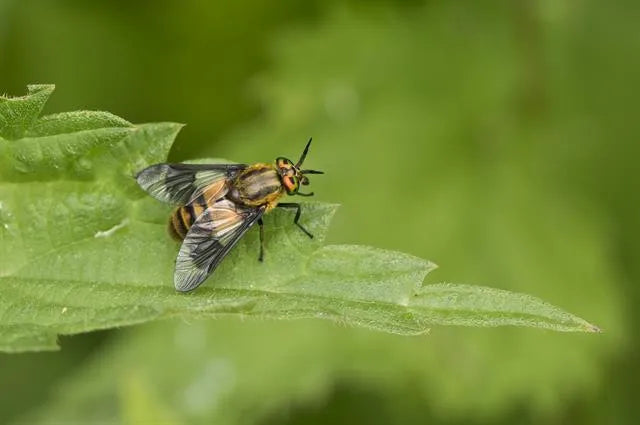
Deer Flies: What They Are, Why They Bite, and How to Avoid Them
Share
🪰 What Is a Deer Fly?
A deer fly is a small, fast-flying bloodsucking insect known for its painful bite and relentless pursuit of humans and animals. Found mainly in wooded and wet areas, deer flies are a seasonal pest that can ruin hikes, farm work, and outdoor fun.
✅ Quick Deer Fly Identification:
-
Size: 6–12 mm long (smaller than a horse fly)
-
Wings: Clear with dark bands or spots
-
Body: Yellow or brown with stripes
-
Eyes: Large, iridescent green or gold
-
Bite: Sharp and painful—causes bleeding
Deer Fly Life Cycle
Understanding the deer fly’s life cycle can help you reduce local populations and avoid their bites.
1. Egg Stage
-
Laid in clusters on plants near water
-
Hatch in 5–12 days
2. Larval Stage
-
Carnivorous larvae live in moist soil or mud
-
Feed on insect larvae, small worms, and decaying material
-
Lasts several months to a full year
3. Pupal Stage
-
Transformation stage before becoming adults
-
Lasts 1–3 weeks
4. Adult Stage
-
Live 30–60 days
-
Females feed on blood; males feed on nectar
🟢 Related Query: When is deer fly season?
👉 Peak activity: Late spring to mid-summer (May–August in most regions)
🩸 Why Do Deer Flies Bite?
Only female deer flies bite because they need blood to produce eggs.
🛠️ How They Bite:
-
Slice the skin open with scissor-like mouthparts
-
Lap up the blood rather than sucking it
-
Result: Painful, itchy, and often bleeding bites
They’re attracted by:
-
Body heat
-
Carbon dioxide (CO₂)
-
Movement
-
Dark colors
🟠 Related Search Query: Why are deer fly bites so painful?
👉 Their mouthparts cut instead of pierce—this makes the bite feel like a sting or burn.
⚠️ Are Deer Fly Bites Dangerous?
While most bites are harmless (aside from irritation), deer flies can transmit diseases in rare cases.
Potential Deer Fly Diseases:
-
Tularemia (Rabbit Fever) — a bacterial disease
-
Loiasis — a tropical disease (not present in North America)
🛑 Scratching can lead to secondary infections. Clean bites with soap and water and apply antiseptic.
🌍 Where Are Deer Flies Found?
Deer flies are common in North America and thrive in:
-
Forests
-
Marshes
-
Swamps
-
Near rivers and lakes
📍 They are most active in hot, humid areas and are frequently encountered by hikers, hunters, and farmers.
🛡️ How to Avoid Deer Flies (Prevention Tips)
✅ Best Ways to Prevent Deer Fly Bites:
-
Wear Light-Colored Clothing – Avoid black, navy, or red.
-
Use Insect Repellent – Look for DEET, picaridin, or oil of lemon eucalyptus.
-
Avoid Peak Hours – Deer flies are most active 10 a.m. – 4 p.m.
-
Stay Still – They’re attracted to movement.
-
Use Deer Fly Traps – Sticky traps or blue cup traps reduce local populations.
🧢 Pro tip: Wear a blue plastic cup coated with Tanglefoot on your hat—they’re drawn to blue and movement!
📊 Deer Fly vs Horse Fly
| Feature | Deer Fly | Horse Fly |
|---|---|---|
| Size | Smaller (6–12 mm) | Larger (10–25 mm) |
| Wing Pattern | Dark bands/spots | Clear or uniformly dark |
| Bite Pain | High | High |
| Behavior | Persistent, head area | Larger prey like livestock |
| Season | Early–mid summer | Mid–late summer |
🧠 Final Thoughts
Deer flies may be small, but their presence can turn a beautiful day outdoors into an itchy nightmare. Knowing how to identify them, understand their life cycle, and avoid bites can make a big difference—especially during peak deer fly season.
If you live in or explore wooded or wetland areas, take steps to protect yourself with repellents, light clothing, and traps. Deer flies are a part of nature—but with a little knowledge, you can keep them from ruining your summer.
📌 FAQ About Deer Flies
Q: What attracts deer flies?
A: Heat, carbon dioxide, movement, and dark colors.
Q: How long do deer flies live?
A: Adults live 30 to 60 days, but the larval stage can last up to a year.
Q: Do deer flies carry disease?
A: Rarely. They can transmit tularemia, but this is uncommon.
Q: How do I stop deer fly bites from itching?
A: Wash with soap and water, apply ice, antihistamine cream, or calamine lotion.
